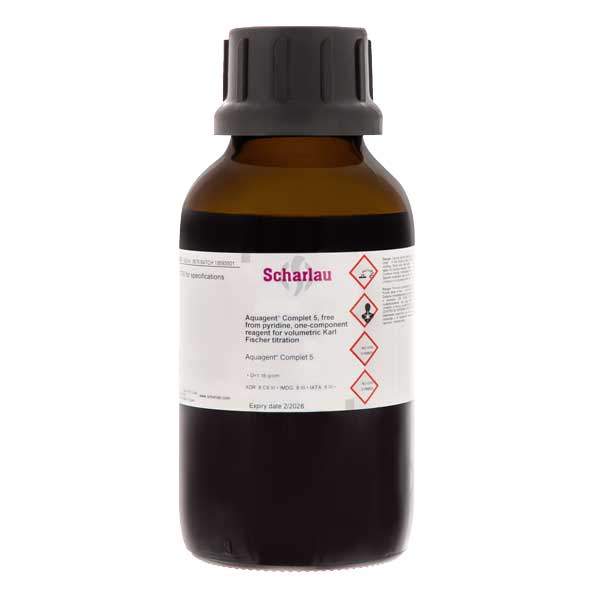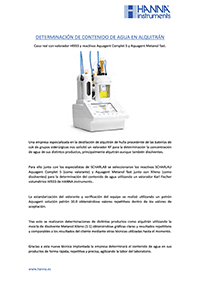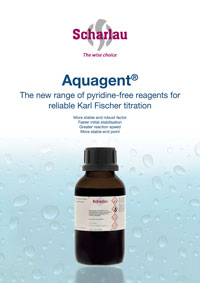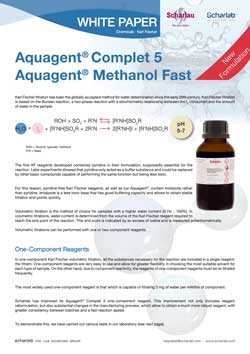Karl Fischer water content titration
27 de November de 2023On many occasions it is essential to know the amount of water present in a sample. Water can influence the reactivity, stability, and shelf life, etc, of products. Karl Fischer water content titration has been the globally accepted method since the beginning of the 20th century. It is based on the Bunsen reaction, a fast, two-phase reaction, with a stoichiometric relationship between the I2 consumed and the amount of water in the sample.
The first KF reagents developed contained pyridine in their formulation, supposedly essential for the reaction, but later experiments showed that pyridine only acts as a buffer substance, and could be replaced by other basic compounds capable of carrying out the same function. For this reason, the new Karl Fischer Aquagent® reagents contain imidazoles instead of pyridine, alternative bases with good buffering capacity that allow stable titration end points to be quickly obtained.
The newly developed manufacturing and control method allows us to launch a new Aquagent® with multiple advantages for the user.
Scharlau’s new Aquagent® formulations achieve a more stable and robust Karl Fischer factor, faster stabilisation, a greater reaction speed and a more stable endpoint.
Karl Fischer water content titration methods
There are two methods based on Karl Fischer titration for the determination of water in a sample: volumetric and coulometric. The choice of one over the other depends upon the quantity of water expected in the sample. Choosing the correct method is essential to obtain accurate, reliable results.
For samples with a medium-to-high water content, the better option is the volumetric method, as it can be used to analyse samples with a water content above 0.1%. When the water content is between 10 and 1000 ppm, the more suitable method is coulometric titration, as the volumetric method is not sensitive enough.

Volumetric titrations
Two types of reagents can be used when performing a volumetric method. For inexpensive, easy titrations, with greater flexibility in the titration procedure, one-component reagents are the best choice. These reagents contain all the elements necessary for the Karl Fischer reaction, so they are very sensitive to moisture and the KF factor needs to be checked frequently. Having chosen a one-component reagent, the sample just needs to be dissolved in dry methanol.
For faster titrations and a more stable endpoint, two-component reagents are the preferred option. In this case, the elements involved in the reaction are contained in two reagents: the solvent, used to dissolve the sample; and the titrant reagent. This type of titration uses less reagent and there is no need to recalculate the titrant’s KF factor.
Coulometric titrations
In the case of coulometric titrations, the type of cell determines which reagents should be used. When using a cell with a diaphragm, then one reagent must be used for the anode compartment and another for the cathode. However, if it is a cell without a diaphragm, a single reagent that contains all the elements necessary for the reaction must be chosen.
Special titrations
The Karl Fischer technique can analyse samples of any nature, but special additives or reagents are sometimes needed to initiate the reaction, depending on the conditions and properties of the sample.
Two-component reagents are recommended for samples with a high fat or oil content, replacing conventional Aquagent® Solvent for solvents specifically designed to dissolve fats and oils, such as Aquagent® Solvent CM and Aquagent® Solvent Oil. These reagents contain chloroform (Aquagent® Solvent CM) or 1-hexanol (Aquagent® Solvent Oil) to increase the solubility of long-chain hydrocarbons.
When dealing with samples with a high aldehyde and ketone content, always avoid general purpose reagents with methanol as solvent. Aldehydes and ketones can react with methanol, generating water as a by-product. To avoid this problem, we recommend Aquagent® Complet K in combination with Aquagent® Medium K, both methanol-free and designed for accurate results when working with aldehydes and ketones.
Additives
When testing foods with a high sugar content that is hard to solubilise, then a viable alternative is to add formamide to the solvent. The usual ratio is 20 parts methanol to 10 parts formamide, accompanied by a one-component reagent. It is not recommended to use a coulometric method for this type of sample.
Acidic samples can be analysed by volumetric methods with one- or two-component reagents. If you decide to use a one-component reagent, it is advisable to add Aquagent® Buffer Acid to the solvent to neutralise any acid present. When working with a two-component reagent, Aquagent® Buffer Acid should be added along with Aquagent® Solvent. The exact amount needed will depend on the sample, considering that the reagent has a buffer capacity of 5 mmol of acid per mL of buffer.
When analysing acid samples via the coulometric method, it is recommended to add 20 g of imidazole to every 100 mL of reagent in the cell, whether with or without a diaphragm.
New Aquagent® advantages
Scharlau’s Aquagent® line for Karl Fischer water content titration has been reformulated with changes and improvements in the manufacturing process. The new formulations offer:
- More stable and robust factor
- Faster initial stabilisation
- Greater reaction speed
- More stable endpoint
- Greater homogeneity between batches and within the same batch
- Suitable for a wide variety of matrices
- Greater variety of formats
- Less environmental impact
- Longer shelf life
Manufacturers of Karl Fischer titrators recommend Aquagent®
Leading manufacturers of Karl Fischer titration equipment, including Metrohm, Mettler-Toledo and Hanna, recommend Scharlau’s Aquagent® reagents.
For further information or to enquire about other products or services, please write to helpdesk@scharlab.com.

 Rest of the World
Rest of the World






